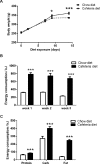Cafeteria diet impairs expression of sensory-specific satiety and stimulus-outcome learning
- PMID: 25221530
- PMCID: PMC4146395
- DOI: 10.3389/fpsyg.2014.00852
Cafeteria diet impairs expression of sensory-specific satiety and stimulus-outcome learning
Abstract
A range of animal and human data demonstrates that excessive consumption of palatable food leads to neuroadaptive responses in brain circuits underlying reward. Unrestrained consumption of palatable food has been shown to increase the reinforcing value of food and weaken inhibitory control; however, whether it impacts upon the sensory representations of palatable solutions has not been formally tested. These experiments sought to determine whether exposure to a cafeteria diet consisting of palatable high fat foods impacts upon the ability of rats to learn about food-associated cues and the sensory properties of ingested foods. We found that rats fed a cafeteria diet for 2 weeks were impaired in the control of Pavlovian responding in accordance to the incentive value of palatable outcomes associated with auditory cues following devaluation by sensory-specific satiety. Sensory-specific satiety is one mechanism by which a diet containing different foods increases ingestion relative to one lacking variety. Hence, choosing to consume greater quantities of a range of foods may contribute to the current prevalence of obesity. We observed that rats fed a cafeteria diet for 2 weeks showed impaired sensory-specific satiety following consumption of a high calorie solution. The deficit in expression of sensory-specific satiety was also present 1 week following the withdrawal of cafeteria foods. Thus, exposure to obesogenic diets may impact upon neurocircuitry involved in motivated control of behavior.
Keywords: Pavlovian conditioning; devaluation; incentive value; obesity; sensory-specific satiety.
Figures





References
LinkOut - more resources
Full Text Sources
Other Literature Sources

